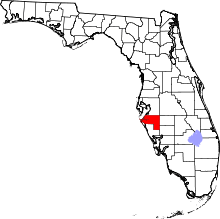Angola, Florida
Angola was a prosperous community[1]:232 of up to 750 maroons (escaped slaves)[2]:71 that existed in Florida from 1812[2]:72 until Florida became a U.S. territory in 1821, at which point it was destroyed. The location was along the Manatee River in Bradenton, Florida, near Manatee Mineral Springs Park.[3] The exact location is not known, but it is the subject of active, ongoing archaeological research.[4][5] Archeological evidence has been found.[2]
"There is virtually no surviving evidence about the community's government, culture, or daily activities."[1]:232
Spanish Florida was a haven for escaped slaves and for Native Americans deprived of their traditional lands, both during colonial U.S. times and in the first decades of U.S. Independence. The "Underground Railroad" ran south during this period.[6][7][8] Originally escaped slaves were welcomed into Florida by Spain, which gave them freedom if they would convert to Catholicism. Under heavy U.S. pressure, Spain rescinded this welcome, but the change had little practical effect. Occupied with the Napoleonic War and with many colonies in revolt or close to revolt, Spain had neither resources nor inclination to capture and return escaped slaves. (At one point, it invited the slaveowners to recapture them themselves.)
There were three autonomous black communities living in Spanish Florida, not simultaneously. Fort Mose, abandoned in 1763 with the British takeover of Florida, was the first and smallest; it was heavily influenced by neighboring St. Augustine. The second was at Prospect Bluff, on the Apalachicola River, destroyed by forces under the command of General Andrew Jackson in 1816. Angola, farthest from the border of Georgia, was the last of these settlements to survive. According to historian Canter Brown, Jr., "Most maroon settlements were tiny because people needed to escape detection. Angola’s 600 to 750 people was an incredible size back then, and shows that these were capable people."[2]:73 He described it as "one of the most significant historical sites in Florida and perhaps the U.S."[2]:71
None of these were settled as a group, as white colonies were; refugees gradually accumulated over many years until a community of several hundred existed. Some refugees from the Negro Fort calamity came to Angola,[9]:5 as did refugees from Lake Miccosukee Village and the Battle of Suwanee.
Destruction of Angola
When Andrew Jackson became Florida's de facto territorial governor in 1821[, and] "acting in direct defiance of Secretary of War John C. Calhoun, Jackson's first order of business was to send his Creek allies on a search and destroy mission against Angola,"[1]:250 which was "burned to the ground".[2]:73 The result of the raid was "terror" all over Florida, and all the blacks who could left for the Bahamas.[1]:250–252
A small number joined Red Stick Indians and formed a community called Minatti at the headwaters of the Peace River.[1]:252
Commemoration
In July, 2018, the first Back to Angola Festival was held at the Manatee Mineral Springs Park.[2]:71 Descendants who had escaped to the Bahamas were expected to attend.[2]:73
See also
References
- 1 2 3 4 5 Millett, Nathaniel (2013). The Maroons of Prospect Bluff and Their Quest for Freedom in the Atlantic World. University Press of Florida. ISBN 9780813044545.
- 1 2 3 4 5 6 7 8 Eger, Isaac (July 2018). "Angola's Ashes: A newly excavated settlement highlights Florida's history as a haven for escaped slaves". Sarasota Magazine. Vol. 40 no. 11. pp. 70–73.
- ↑ Young, Mark (March 24, 2018). "Slaves had key stop to freedom in Bradenton. It's drawing international attention". The Bradenton Herald. Retrieved June 7, 2018.
- ↑ Vickie Oldham, Uzi Baram (May 12, 2011). "Escaped Slave Community of Angola". C-SPAN Cities Tour. C-SPAN3. American History TV. Retrieved March 20, 2018.
- ↑ Baram, Uzi (June 2008). "A Haven from Slavery on Florida's Gulf Coast: Looking for Evidence of Angola on the Manatee River" (PDF). African Diaspora Archaeology Network Newsletter. Retrieved March 20, 2018.
- ↑ Smith, Bruce (March 18, 2012). "For a century, Underground Railroad ran south". Google News. Associated Press. Archived from the original on March 21, 2012. Retrieved March 23, 2012.
- ↑ National Park Service. "Aboard the Underground Railway. British Fort". Retrieved February 10, 2018.
- ↑ McIver, Stuart (February 14, 1993). "Fort Mose's Call To Freedom. Florida's Little-known Underground Railroad Was The Escape Route Taken By Slaves Who Fled To The State In The 1700s And Established America's First Black Town". Sun-Sentinel. Retrieved February 15, 2018.
- ↑ Brown, Jr., Canter (2005). "Tales of Angola: Free Blacks, Red Stick Creeks, and International Intrigue in Spanish Southwest Florida, 1812–1821". In Brown, Jr., Canter; Jackson, Jr., David H. Go Sound the Trumpet! Selections in Florida's African American History. University of Tampa Press. pp. 5–21. ISBN 187985242X.
